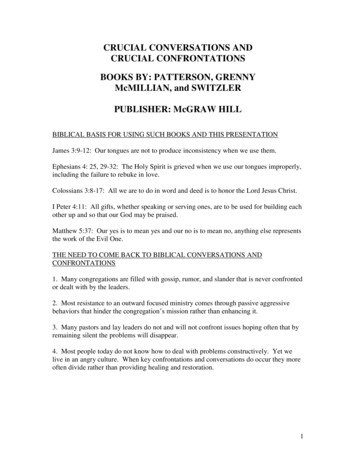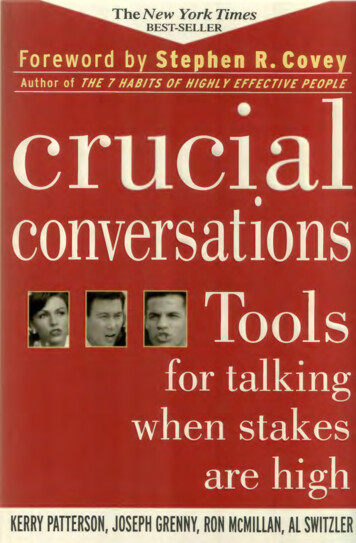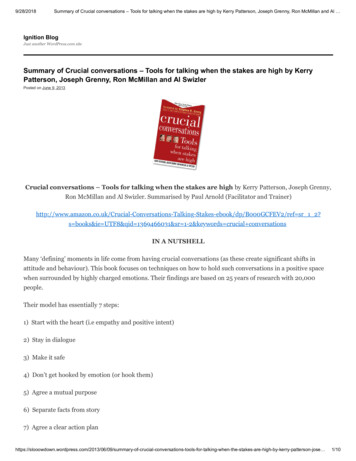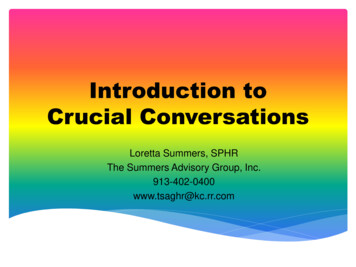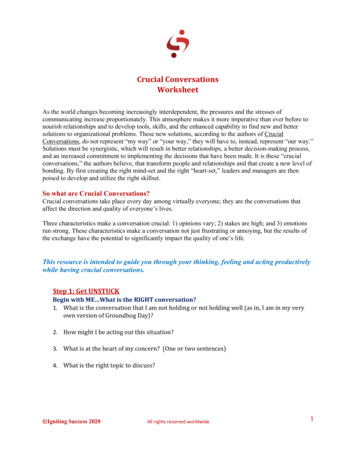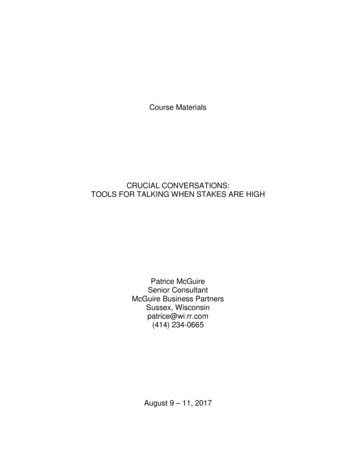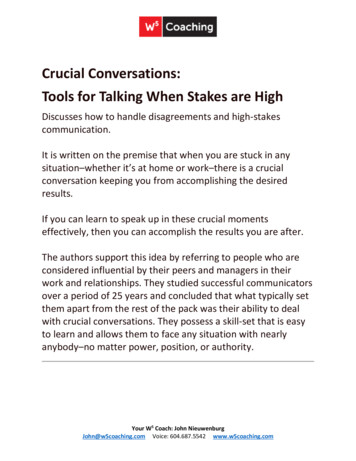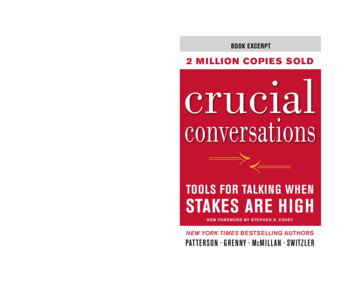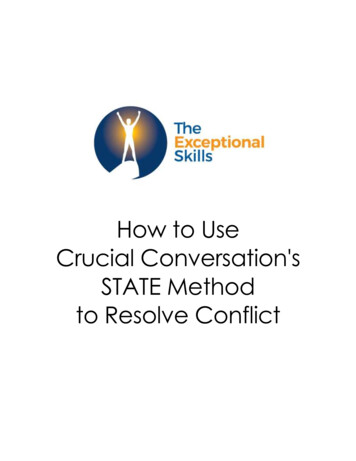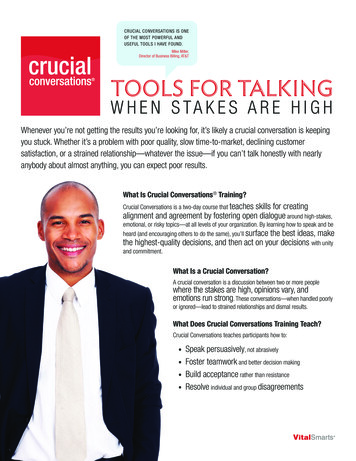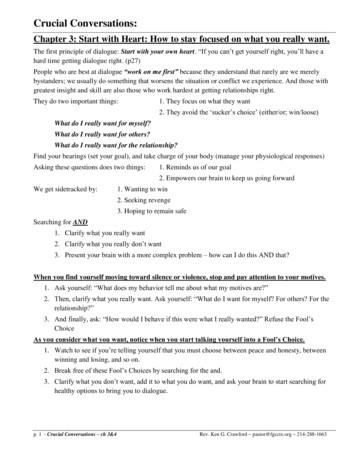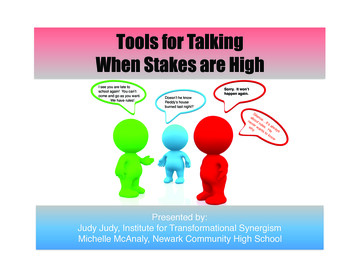
Transcription
Tools for TalkingWhen Stakes are HighI see you are late toschool again! You can’tcome and go as you want.We have rules!Sorry. It won’thappen again.Doesn’t he knowReddy’s houseburned last night?Silab encne out e Ive rul t’swh r wa es. alwants He ysy.toknowPresented by:Judy Judy, Institute for Transformational SynergismMichelle McAnaly, Newark Community High School
Impact Map – Crucial ConversationsWhat I will learn(The few, most important skills orconcepts I’ll learn during thetraining)At the completion of thissession, I will have the tools toIdentify conversations that keepme stuckStay in dialogue by:§ not moving to silence or“violence” when I’m angry,scared or hurt§ diffusing others’ violenceand eliminating their silence§ establishing and maintainingmutual purpose and mutualrespectGet my meaning acrosspersuasively, not abrasively, evenwith difficult or potentiallythreatening messagesShare facts, ideas, feelings andopinions candidly and honestlywhile making it safe for othersto do the sameHow I will apply these newskills back on the jobIdentify and agree on the fewimportant outcomes that theconversation should attempt toproduce; keep that list in the centerof the conversationResolve disagreements andaccurately address concerns bytalking respectfully, candidly andskillfully with othersBuild acceptance rather thanresistance by giving and receivingfeedback in a factual, unemotional,non-judgmental, way that enhancesrelationships and improves results.Talk about high-stake, emotional andcontroversial topics safely andfreely, without either myself or theother party resorting to silence orstrong negative emotionsFinish conversation with an agreedupon plan and/or clearly definednext steps, and assure sharedresponsibilities for improvingworking relationships and outcomesWhat results I will get(How will applying my new skillsimprove the results of my workarea?)Save time with fewer, moreproductive meetingsHave less disagreement, orresolve disagreements morequicklyBuild more alignment with betterdecisions[Add to/Delete from/Editthese as appropriate]The organization’s* goals thatmy results will support(*Organization could mean my workgroup, department, school/division,or Rice University)
My Impact MapWhat did I learn?(The few, most important skills orconcepts I learned during the training)How will I applythese new skillsback on the job?What results I willget?(How will applyingmy new skillsimprove myconversations?)What organizationgoals will results?(What could theseskills mean to mystudents, colleagues,department, school)
ACCOUNTABILITY CONVERSATION PLANNERCPR. As you think about the various facets of your problem, do you want to discussContent, Pattern, or Relationship? To help you decide, ask yourself what you really wantfrom the conversation.My IssueDescribe the Gap. Start by sharing what was expected vs. what was observed.Expected: “My understanding was that you were going to.”Observed: “Instead, you.”End with a question: “What happened?” “How do you see it?”Make It Safe. How might the other person misinterpret your intent? Create a contrastingstatement that restores safety.“I don’t want.”“I do want.”Make It Easy: What ability barriers might be keeping the person from doing what isexpected? Think about all three Sources of Influence:Personal Ability: What skill or knowledge might be needed?Social Ability: How might others (you, peers, etc.) be withholding information,materials, or help?Structural Ability: What things (policies, procedures, equipment, software, etc.) arepreventing the person from doing what’s required?Ask the person for ideas in brainstorming solutions.Make It Motivating: If the person isn’t motivated, clarify natural consequences by makingthe invisible visible. Think of all three sources.Personal Motivation: How can you make the behavior you want from the other personcongruent with his or her values?Social Motivation: How are others (you, peers, etc.) perceiving or being impactedby the behavior?Structural Motivation: What punishments might occur if he or she doesn’t enact thebehavior? What rewards are possible through enacting the behavior?Move to Action: Don’t forget to end by determining Who does What by When and Follow up.
SIT UAT I O N1Results and Relationshipsare suffering due to a gap.2You need to initiate anAccountabilityConversation, or one is evolving.3You are getting emotional ortelling clever stories.PR I NCI PLE S & SKI LL SYou need to hold an Accountability Conversation. Identify where you are stuck. Unbundle with CPR.Start with Heart Focus on What You Really Want for you, them, the relationship, andthe organization (your long-term results).Master Your “Clever” Stories—Tell the Rest of the StoryVictim Story:“What am I pretending not to notice about my role in the problem?”Villain Story:“Why would a reasonable, rational, decent person do this?”Helpless Story:“What should I do right now to move toward what I really want?”4You have a tough message,be honest and maintainsafety.5Someone misunderstandsyour intent regardingPurpose or Respect.Describe the GapDescribe expected vs. observed: “We agreed that you’d ” “I noticed ”End with a question: “How do you see it?” “Help me understand ”Contrast“I don’t think/mean/want“I do think/mean/want(their fear/misunderstanding).”(your actual purpose/meaning).”6You’re not sure whythe gap exists.Think Six SourcesSource 1: Do they like the behavior you want?Source 2: Do they know how?Source 3: Do others encourage?Source 4: Do others enable?Source 5: Do carrots and sticks motivate?Source 6: Do the environment and tools enable?7Ability barriers are causingthe gap.Make It EasyClarify boundaries: “Our time constraints are . . .” “We only have budgeted . . .”Start by asking for their ideas: “What do you think would help?”Brainstorm all sources: Personal, social, structural solutions8The other person doesn’tseem motivated to closethe gap.9You’re ready to Move toAction.Blue-2Day-ACP-v2Clarify Natural ConsequencesSource 1: How will this affect them personally?Source 3: Introduce hidden victims —who else might be affected?Source 5: Connect to existing carrots and sticks —what are the rewards orpunishments associated with the action?Move to Action—Determine Who does What by When and how we willFollow up. 2013 VitalSmarts. All Rights Reserved. Rev 1.0
Influencer Self-AssessmentThis survey was designed by Vital Smarts to help you increase your ability to influence others’ behavior.The questions below examine influence methods you use to help others change. Your survey results willbe more useful if you think about how you typically approached influence challenges.Areas you may consider include:1. An individual who is resistant to your ideas. (My son is living in my basement and lacks ambition to dosomething with his life.)2. A group whose behavior is tough to change. (My teammates fail to capture and document customerleads when we go to trade shows.)3. An organization that could be much more effective if its people changed their behavior. (We do notshare information and resources across teams.We act as though we are in silos.)With one challenge in mind, answer the following questions.1. Focus and Measure1. As I try to influence change I take a lot of time up front to ensure everyone isvery clear about and committed to the results we are trying to agreeAgreeStronglyAgree2. To help others stay focused and excited about the change we’re undergoing, Ishare frequent measures that demonstrate our sagreeAgreeStronglyAgree3. To ensure that we’re not encouraging people to continue with their old, unhealthyactions, I remove or modify measures that drive the wrong isagreeAgreeStronglyAgree4. To help achieve challenging goals I help others break long-term goals into dailyor weekly milestones that encourage steady sagreeAgreeStronglyAgree2. Find Vital Behaviors1. When trying to influence others, I am very clear about the specific behaviors thatpeople need to change rather than relying on vague values or generic qualities Ihope they’ll reeAgreeStronglyAgree2. I make sure we reduce the list of possible actions to the two or three that willproduce the greatest amount of change and improvement in agreeAgreeStronglyAgree
3. I ensure everyone agrees on the two or three behaviors that need to change in order for us to achievethe results we lyDisagreeDisagreeAgreeAgree4. I take frequent measures of these key behaviors, as well as results, to see if my influence efforts DisagreeDisagreeAgreeAgree3. Help Them Love What They Hate1. Whenever possible I invite people to try out and test new things rather than use authority or pressureto compel eeDisagreeAgreeAgree2. I go beyond business and economic arguments to help people see the moral imperatives that call isagreeDisagreeAgreeAgree3. I avoid giving lectures or logical arguments for why others should change and instead tell compellingstories that illustrate the human and moral reasons that call for greeDisagreeAgreeAgree4. I find creative ways to engage people in direct experiences (field trips, pilot programs, simulations, etc.)that will help them feel differently about the need for greeDisagreeAgreeAgree4. Help Them Do What They Can’t1. I spend time offering coaching, hints, tips, and practice opportunities to those I am trying to DisagreeDisagreeAgreeAgree2. I invest as much time and effort in ensuring others have the skills and abilities they need to succeed as Ido in trying to motivate them to greeDisagreeAgreeAgree3. I help others develop skills in ALL the areas that may be required—including the social, emotional, andinterpersonal skills and not just the technical, physical or mental skills they eeDisagreeAgreeAgree4. I create lots of opportunities to help people practice new skills under safe but in realisticallychallenging DisagreeDisagreeAgreeAgree
5. Provide Encouragement1. I make sure those around me see clear evidence that I am willing to sacrifice a great deal (ego, time,money, or other priorities) in order to demonstrate my sincere desire to create greeDisagreeAgreeAgree2. I carefully identify opinion leaders and create a specific strategy to get them involved in encouragingothers to greeDisagreeAgreeAgree3. I make sure people in positions of authority teach, model, praise, and coach others toward the yDisagreeDisagreeAgreeAgree4. I create an environment where everyone is encouraged to hold everyone else accountable for the newbehavior (including myself)—irrespective of level or sagreeDisagreeAgreeAgree6. Provide Help1. I make sure that others have timely assistance whenever they run into roadblocks trying out the lyDisagreeDisagreeAgreeAgree2. I identify the toughest moments or biggest obstacles to change and make sure that people have othersaround them to help with these DisagreeDisagreeAgreeAgree3. I create safe ways for people to get help without feeling embarrassed or being put on the eeDisagreeAgreeAgree4. I provide everyone with the authority they need to step up to new isagreeAgreeStronglyAgree7. Change Their Economy1. I put much more effort into sharing the moral, personal, business, and other reasons to change thaninto trying to reward or punish people into sagreeDisagreeAgreeAgree2. I ensure that our formal reward and discipline systems encourage rather than discourage peoplearound trying a new sagreeDisagreeAgreeAgree
3. I make careful use of small yet thoughtful rewards to encourage people who make early attempts sagreeDisagreeAgreeAgree4. I use formal rewards to encourage not just the right results, but the right behaviors to get those agreeDisagreeAgreeAgree8. Change Their Space1. I use whatAgreeStronglyAgree2. I make sure people have easy access to the tools, information, and resources they need in order to adoptnew isagreeDisagreeAgreeAgree3. Where possible, I redesign the physical space of those I’m trying to influence in order to make goodbehavior easier to remember and to do—and bad behavior greeDisagreeAgreeAgree4. Where possible, I change the physical environment (moving people or things closer together or fartherapart, organizing work flow, etc.) in ways that make the new behavior a more automatic part of thenatural flow of life or work so people do the right thing without sagreeDisagreeAgreeAgreeVitalSmarts.com
Training Course DetailsCrucial Conversations Training infuses fourteen hours of classroom time withmore than 60 original video clips of “before and after” situations. Enjoy videobased instruction from the authors of Crucial Conversations: Tools for TalkingWhen Stakes are High. Engage in extensive in-class practice, group participation,and personal reflection as you explore and master these crucial skills.Lesson 1:Get Unstuck Spot the conversations that are keeping you from what you want. Avoid moving to silence or violence during crucial conversations. Share facts, ideas, feelings, and opinions candidly and honestly.Lesson Two:Start with Heart Identify your own Style Under Stress and manage it. Stay focused on what you really want and maintain dialogue. Understand how motives change when conversations turn crucial.Lesson Three:Master My Stories Stay in dialogue when you’re angry, scared, or hurt—“think” your wayto the root cause of negative emotions. Discover your stories—how do you justify your behavior? Eliminate Victim, Villain, and Helpless Stories, and improve yourresults.Lesson Four:STATE My Path Speak persuasively, not abrasively. Get your meaning across even with potentially threateningmessages. Share strong opinions without shutting down contrary views. State your mind while making it safe for others to do the sameLesson Five:Learn to Look Spot the warning signs that indicate safety is at risk. Notice various forms of silence and violence. Step out of a conversation and notice how to make it work.Lesson Six:Make It Safe I Take steps to rebuild safety and return to dialogue. Talk about almost anything—without silence violence. Use specific skills to keep everyone sharing information.Lesson Seven:Make It Safe II Establish and maintain mutual purpose and mutual respect. Recognize when you’re at cross-purpose.Lesson Eight:Explore Others’ Paths Use exploring skills to make it safe for others to speak up. Diffuse others’ violence and eliminate silence. Get safely to the meaning behind others’ emotions.Lesson Nine:Move to Action Put Crucial Conversations principles and skills together. Move from healthy dialogue to taking action and achieving results.
THE CAPACITY TO MASTERCRUCIAL CONVERSATIONSDOES NOT SIMPLY PREDICTINDIVIDUAL EFFECTIVENESS—ITIS ALSO ONE OF THE MOSTPOTENT DRIVERS OFORGANIZATIONALPERFORMANCE.Kerry PattersonIf your team or organization struggles to deal effectively with difficultsubjects, undercommunicates, or fails to act with unity and conviction,Crucial Conversations Training is for you.Participant Materials Crucial Conversations Participant Toolkit (157-page trainingworkbook) Cue cards and model card A copy of Crucial Conversations: Tools for Talking When Stakes areHigh, 2nd edition Crucial Conversations Audio Companion A course completion certificate Post-training participant website: videos, exercises, assessments,additional reading, and more (ChangeAnything.com)
Impact Map – Crucial Conversations What I will learn (The few, most important skills or concepts I’ll learn during the training) How I will apply these new skills back on the job What results I will get (How will applying my new skills improve the results of my work area
